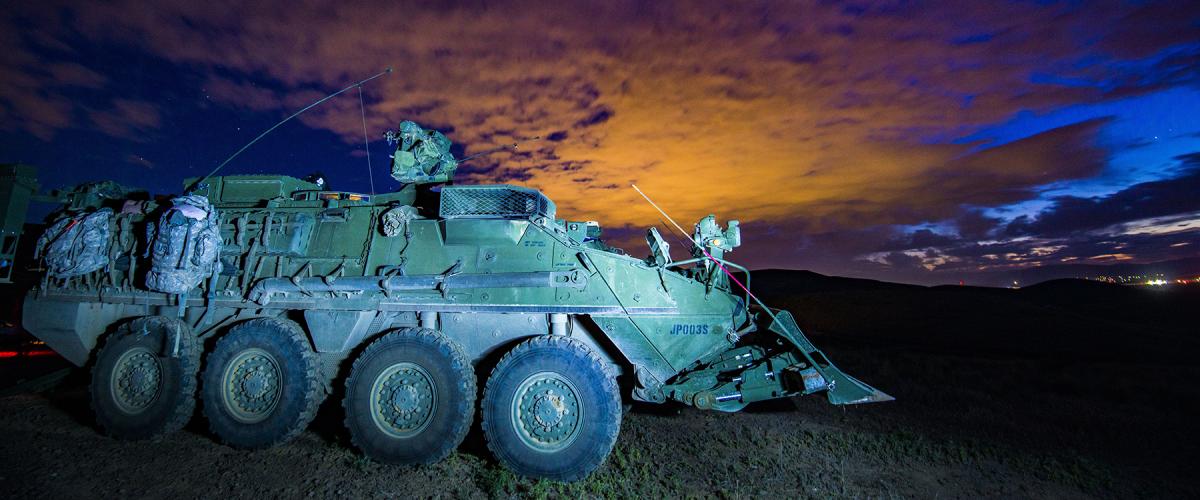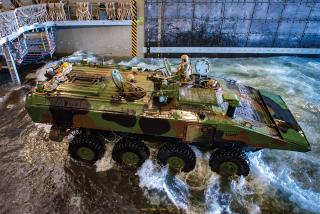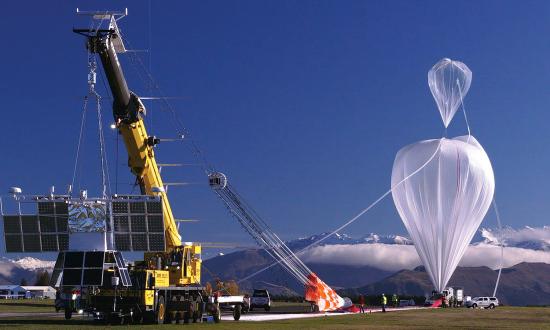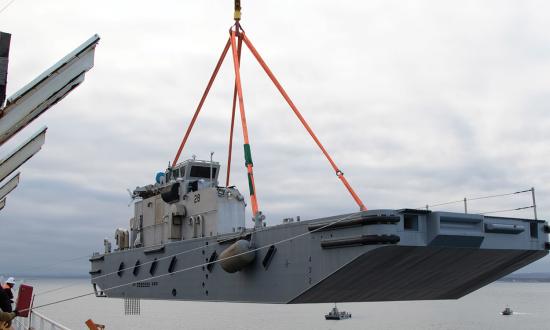Engineering operations will be of substantial importance to expeditionary advanced base operations (EABO). The Tentative Manual for Expeditionary Advanced Base Operations highlights the difficulty and complexity of engineering tasks, particularly because of the equipment currently available to Marines. As the manual notes:
Relying on organic capabilities of the littoral force to execute general engineering tasks typically requires significant transportation due to the size and weight of engineering and construction equipment and materiel. Transporting heavy equipment or material handling equipment creates a significant signature and is unavoidable. Local contracting may mitigate this concern, but OPSEC [operational security] may be compromised in the process if additional efforts to hide intent are not included in planning and execution, especially in competition when multiple projects can occur to support future operations.1
The problems could be mitigated or eliminated if the Marine Corps developed an engineering vehicle based on the Amphibious Combat Vehicle (ACV). For some engineering missions, OpSec risks would be mitigated, because engineers would not need to procure equipment locally. An engineering ACV—call it the “advanced combat engineering vehicle” (ACEV)—could move itself from ship to shore, and it would share parts with the rest of the ACV fleet, reducing maintenance and logistics challenges.
The only previous Marine Corps amphibious engineering vehicle was the Landing Vehicle, Tracked, Engineering, Mk 1 (LVTE1), long since retired.2 It was an engineering variant of the Mk 5 Landing Vehicle, Tracked, Personnel (LVTP-5). LVTPs entered service in the 1950s and saw combat in the Vietnam War. They were replaced by the Amphibious Assault Vehicle 7 (AAV-7) family, which is now being replaced by the ACV family. Unlike the M9 Armored Combat Earthmover or M1150 Assault Breacher Vehicle, the LVTE1 was capable of independent ship-to-shore amphibious movement.
Though slightly smaller and moderately lighter than the LVTP-5, the ACV still has potential for further development. The baseline ACV’s payload capacity is 7,280 pounds, and this capacity is being put to use in variants under development: some armed with a remotely operated 30-mm auto-cannon (instead of the original .50-caliber machine gun); a recovery variant equipped with a crane; and a vehicle equipped with a C4 system and unmanned aerial systems payload.3
The ACEV would need to incorporate a front-mounted blade like the LVTE1. While the LVTP-5 family had loading ramps at the front, the ACV’s ramp opens rearward, from the back, making it easier to incorporate a front mount. This would simplify mounting a mine plow or earthmoving blade while still allowing easy on and off for the engineers or infantry Marines. The added weight of the blade might cause the vehicle to trim by the bow when swimming, but the LVTE1 mitigated this by mounting positively buoyant tanks to the back side of the blade.4 The ACEV’s blade also could be counterweighted by adding a ripper, trencher, auger, lane-marking system, or other useful tools at the rear. In terms of design and tactical employment, an ACEV would likely be broadly similar to the M1132 Engineer Squad Vehicle variant of the Army’s Stryker Combat Vehicle. While the M1132 weighs less than half as much as the ACV, it can be equipped with a mine plow, mine roller, or obstacle blade at its front.5
The ACEV’s earthmoving capabilities would be very helpful for EABO. As the Tentative Manual notes: “Missions that engineer units conduct . . . include . . . : engineer reconnaissance; base camp or site preparation; detection and clearance of explosive hazards; airfield damage repair; horizontal and vertical construction; power generation; heavy equipment support; and bulk-fuel inventory management.” Clearing vegetation and leveling ground will be necessary for many purposes, especially in the austere areas where stand-in forces can expect to operate, and all will require an earthmoving vehicle. The manual specifically lists “concealed and signature managed fuel distribution and storage; runway repair and preparation of potential [forward arming and refueling points]; [and] infrastructure improvement” as tasks critical to EABO “throughout the spectrum of conflict.” An ACEV would play a critical role in each.
ACEVs would be important to the newly formed Marine littoral regiment (MLR). The MLR’s combat team is organized around an infantry battalion and antiship missiles, and it will:
provide the basis for employing multiple platoon-reinforced-size expeditionary advanced base sites that can host and enable a variety of missions such as long-range anti-ship fires, forward arming and refueling of aircraft, intelligence, surveillance, and reconnaissance of key maritime terrain, and air-defense and early warning.6
An engineering ACV could facilitate such operations in a way no existing vehicle can, accompanying the small boats and other connectors and performing its tasks before moving to a nearby EAB under its own power to support engineering operations—or rendezvousing with an amphibious assault ship to reach a more distant objective.
Engineering vehicles also would be useful offensively and defensively for a Marine ground combat element in more traditional land operations. They could reduce obstacles for an attacking Marine ground force, using their mine plows, mine rollers, line-clearing charges, and lane-marking systems to breach minefields and other obstacle belts. The earthmoving blade could be used to fill in antitank ditches and other dug-in obstacles. On defense, they could be used for counter-mobility operations, enabling engineers to emplace obstacles. They could also build vehicle fighting positions and other fortifications to improve defensive positions.
Whatever the future of EABO in conflict may be, Marines will likely be called on to conduct other operations in the competition phase. Former Commandant of the Marine Corps General David H. Berger stressed this point when discussing amphibious capabilities, stating: “When available, amphibious ships allow the U.S. to ‘out compete’ [Chinese] influence by providing rapid crisis response—which includes humanitarian assistance and disaster relief [HA/DR]—to our regional allies and partners.”7 China has spread its influence in a variety of ways, notably economically. While China’s meteoric military growth—including assets useful for HA/DR operations, such as hospital ships—is impressive, that country still lacks the experience the U.S. military has at those types of operations.8
An ACEV would be extremely useful for HA/DR operations, particularly where China is seeking to expand its influence. The Marine Corps has played an important role in such operations around the world, including in Japan, Haiti, Bangladesh, and Nepal. The Navy and Marine Corps team uses helicopters, fixed-wing aircraft, and hovercraft to bring supplies to hard-to-reach islands and coastal areas.9 But the Marine Corps has not always had the right tools for such efforts. For example, in Operation Sea Angel in 1991, AAVs were deployed to support relief efforts in Bangladesh, but they were not able to make it to shore. Their weight and treads caused concern over the possibility of damaging coastal embankments.10
ACEVs could mitigate if not solve these problems outright. Instead of clearing mines, Marines would use the vehicles to clear roads of obstacles such as downed trees and damaged buildings or to rebuild sections of road washed away by floods.
While ACVs are wheeled instead of tracked like AAVs, their weight could still cause damage to relatively fragile coastal infrastructure and natural features. Instead, ACEVs could clear alternate routes for ACVs to carry Marines and supplies ashore with less risk of such damage. Following the immediate operations, such as search and rescue and distribution of emergency supplies, these engineering vehicles could then pivot to supporting construction projects and building field hospitals, temporary shelters, and logistics hubs to facilitate follow-on efforts.
Developing an engineering vehicle based on the ACV would create a versatile tool for all types of operations across the spectrum of conflict. Its capabilities would be well suited for EABO, offensive and defensive land operations, and HA/DR. The ACV has demonstrated its potential for modification, and adopting another variant would simplify logistics and maintenance. In whatever clime and place Marines may be called on to fight the nation’s enemies or aid its allies, an ACEV would be an invaluable asset.
1. Tentative Manual for Expeditionary Advanced Base Operations, 2nd ed. (Washington, DC: Headquarters U.S. Marine Corps, May 2023).
2. “Landing Vehicle, Tracked, Engineer, Mark 1,” American Fighting Vehicle Database, 28 November 2021.
3. Megan Eckstein, “BAE Systems Tests Battle Management System in ACVs, as Company Mulls Future Upgrades and Variants,” USNI News, 18 May 2021; and “Amphibious Combat Vehicle Datasheet,” BAE Systems.
4. “Landing Vehicle, Tracked, Engineer, Mark 1.”
5. “Engineer Squad Vehicle M1132 Stryker,” 1 March 2015, American Fighting Vehicle Database.
6. “Marine Littoral Regiment (MLR),” Marines.mil, 11 January 2023.
7. Naveed Jamali, Alex Rouhandeh, and Tom O’Connor, “Marine Commandant Warns U.S. Lacking in Key Capability for War with China,” Newsweek, 30 March 2023.
8. Kyle Mizokami, “Peace Ark: Onboard China’s Hospital Ship,” USNI News, 23 July 2014.
9. Mohammed Salam, “28 Years Since Operation Sea Angel: A Model in Disaster Management,” The Daily Star, 30 April 2019.
10. Charles R. Smith, Angels from the Sea: Relief Operations in Bangladesh: 1991 (Washington, DC: Headquarters U.S. Marine Corps, History and Museums Division, 1995).







